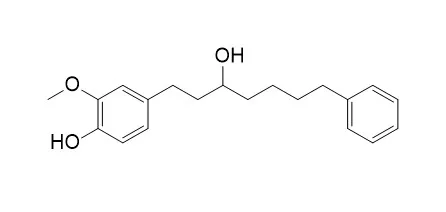| Alpinia oxyphylla (Yizhi) capsularfruits are commonly used in traditional medicine. Pharmacological studies have demonstrated that A. oxyphylla capsularfruits have some beneficial roles. Besides volatile oil, sesquiterpenes, diarylheptanoids and flavonoids are main bioactive constituents occurring in the Yizhi capsularfruits. The representative constituents include tectochrysin, izalpinin, chrysin, apigenin-4',7-dimethylether, kaempferide, yakuchinone A, yakuchinone B, Oxyphyllacinol and nootkatone. Their content levels in the fruit and its pharmaceutical preparations have been reported by our group. The nine phytochemicals are also the major components present in the Yizhi alcoholic extracts, which have anti-diarrheal activities. However, the fates of these constituents in the body after oral or intravenous administration remain largely unknown. In the present study, we focus on these phytochemicals albeit other concomitant compounds. The chemicals and their metabolites in rat plasma were identified using liquid chromatography/tandem mass spectrometry with selected reaction monitoring mode after orally administered Yizhi extract to rats. Rat plasma samples were treated by methanol precipitation, acidic or enzymatic hydrolysis. This target analysis study revealed that: (1) low or trace plasma levels of parent chemicals were measured after p.o. administration of Yizhi extract, Suoquan capsules and pills to rats; (2) flavonoids and diarylheptanoids formed mainly monoglucuronide metabolites; however, diglucuronide metabolites for chrysin, izalpinin and kaempferide were also detected; (3) metabolic reduction of Yizhi diarylheptanoids occurred in rats. Yakuchinone B was reduced to yakuchinone A and then to Oxyphyllacinol in a stepwise manner and subsequently glucuronidated by UDP-glucuronosyl transferase. Further research is needed to characterize the UDP-glucuronosyl transferase and reductase involved in the biotransformation of Yizhi chemicals. |






 Cell. 2018 Jan 11;172(1-2):249-261.e12. doi: 10.1016/j.cell.2017.12.019.IF=36.216(2019)
Cell. 2018 Jan 11;172(1-2):249-261.e12. doi: 10.1016/j.cell.2017.12.019.IF=36.216(2019) Cell Metab. 2020 Mar 3;31(3):534-548.e5. doi: 10.1016/j.cmet.2020.01.002.IF=22.415(2019)
Cell Metab. 2020 Mar 3;31(3):534-548.e5. doi: 10.1016/j.cmet.2020.01.002.IF=22.415(2019) Mol Cell. 2017 Nov 16;68(4):673-685.e6. doi: 10.1016/j.molcel.2017.10.022.IF=14.548(2019)
Mol Cell. 2017 Nov 16;68(4):673-685.e6. doi: 10.1016/j.molcel.2017.10.022.IF=14.548(2019)